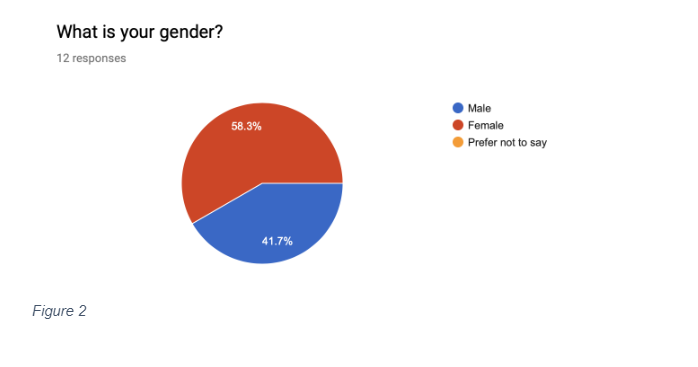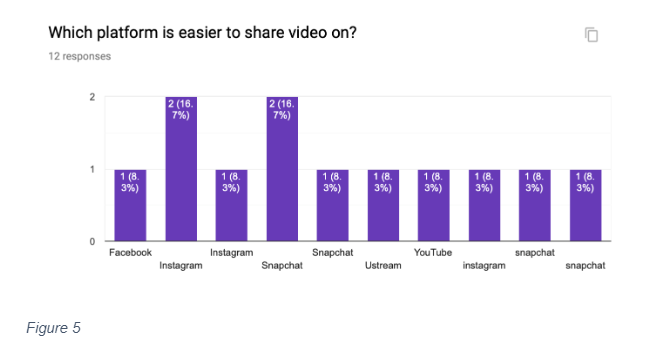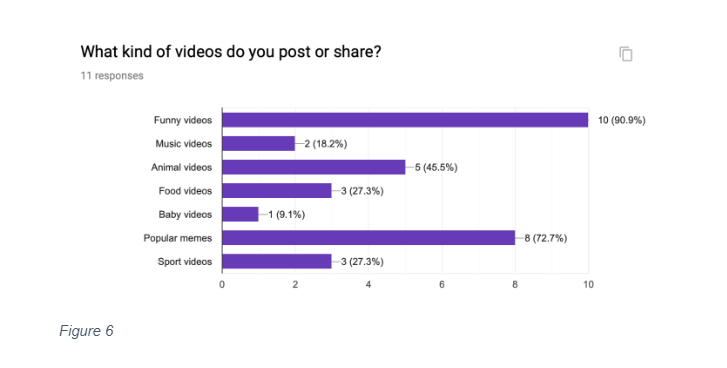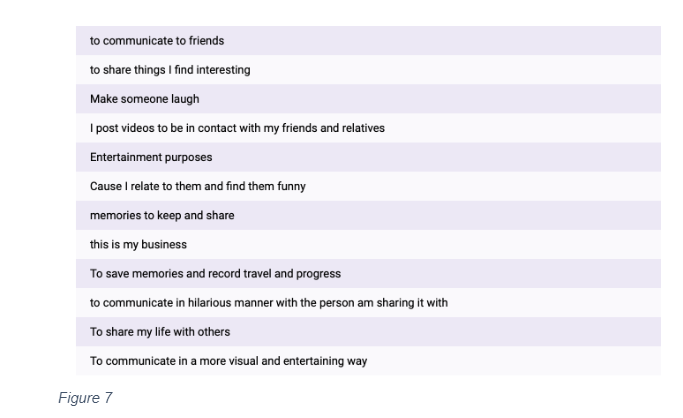Content On Social Media
Introduction
This report provides information obtained through an online survey which was conducted at University of Roehampton involving students of Digital media from the first year. The theme investigated was the reason why students share short videos on the social media. The research was conducted in small groups of two or three people. A main question was given to the groups and they had to create sub questions according to the principal question. The research was conducted by using a Quantitative research method, this type of research is used to quantify the focus of the investigation by creating numerical data or data that can be turned into statistics. Therefore, the information obtained by this method is used to quantify opinions, behaviours, habits and so on, then generalize outcomes from a sample of selected populace. For those seeking detailed assistance, quantitative dissertation help can be invaluable. The methodology applied for the enquiry was Primary research which could be conducted by the Researcher or others could be hired for this purpose. This type of methodology implies the process which propounds the direct approach to the sources. Examples of primary research are questionnaire, surveys and interviews.
Significantly, research ethics are highly important, since it is especially significant to distinguish between acceptable and unacceptable behaviour. Likewise, confidentiality, anonymity and informed consent are the basis of a well-conducted investigation. Thus, confidentiality is vital to the confident relationship between the researcher and respondents and to the trustworthiness of the investigation project.
Additionally, this report contains the findings of the research study, a report of the data obtained through the survey and interpretation of the said data. Finally, the article ends with a conclusion of the enquiry.

Research question:
Why do Year 1 Digital Media Students (at Roehampton University) share short videos on social media with their friends?
Research sub questions:
How old are you?
18-22
23-27
28-31
31+
What is your gender?
Female
Male
Prefer not to say How many social media accounts do you use daily? 1-2 2-3 3+ Do you post or share videos? Yes No Sometimes If yes, how often do you post or share videos? Sometimes Often Very often Which social media platform do you use more? Instagram Twitter Facebook Snapchat Other Is there any particular reason of why you prefer that platform? What kind of videos do you post or share more? Funny Music videos Cute animals Food and recipes Inspiring content Sport What is the main reason do you post videos for?
Types of Research
The enquiry was performed by using a Quantitative research method. The quantitative method has it’s roots in the philosophy of rationalism, it’s structure is inflexible, the purpose is quantifying the grade of variation in a phenomenon. It focuses on the mensuration of variables and on the objectivity of the project. Moreover, this method gives value to the validity of findings, it’s method to inform findings is an analytical and holistic one which is oriented towards designing conclusions which can be generalised.
The methodology used for the investigation was Primary research, the data was gathered through an online survey. This methodology is lead the researcher and implies collection of the data directly, then takes the raw data and uses it for different purposes. it may vary depending on the objective of the research. The aim of the research can be to investigate an existing problem or phenomenon, to give solution to a problem, to create a new system, to obtain new knowledge or a combination of all of these (Hussey and Hussey, 1997)
The online survey was sent by email to all the first year Digital Media students and in order to get maximum data from the students, the survey included open ended questions and close ended questions. The methodology has various advantages, firstly the information gathered is accurate since the researcher and the surveyed come in contact directly, secondly, the survey can be managed remotely via mobile phones, computers, iPads, emails, mails or telephones. Therefore, it enables the researcher to survey people all around the world and it reduces geographical dependence. Thirdly, online survey allows to collect information from a large amount of people, making the enquiry more accurate.
Team work
The investigation was conducted through proper teamwork, the team created clear goals to achieve in a certain amount of time. The members of the team developed the sub questions together according to the main question. The research was set up in Google Docs, which permitted the members of the team to cooperate in real-time through the Web by creating and sharing the questions of the enquiry.
Ethical considerations
Three ethical concepts are at the core of institutional and professional research governance process based on the ‘ ‘Human Subjects Model’ : confidentiality, anonymity and informed consent (Eynon, Fry & Schroeder, 2017: 19). Researchers must ensure the confidentiality of personal information and the privacy of individuals during all the process, even when investigation has concluded. Moreover, researchers have to assure that they meet participants’ expectations of anonymity. Therefore, it is highly important that the data is protected, thus the information needs to be stored with a password-protected and encryption system of the documents to avoid unauthorised access. In addition, individuals who participate in any enquiry must to know and understand what the aim of the investigation is, what are consenting to do, the possible risks and benefits and also know all the details of alternatives options that could benefit them. Similarly, participants have the right to ask any question regarding the research and be informed that their participation is voluntary, it means that they are allowed to withdraw at any time of the research.
Findings







The majority of the respondents were within the age range of 18-24 (75%) and they generally use more than two social accounts daily. The surveyed personnel said that they post videos often, only 8.3% of the respondents never post videos. In addition, Instagram and Snapchat were considered the easier platforms to share videos. Referring to Figure 6, most of the respondents (90%) shared ‘funny videos’, also the majority (72.7%) shared popular memes. Figure 6 also shows that only 9.1% of the respondents share baby videos, and 18.2% shared music videos, as we can see those two categories were the less popular as per their extent of sharing.
According to Figure 7, the main reason to post videos in social media was to communicate with friends and relatives, also a significant reason was for amusing people, since they mostly shared funny videos. Moreover, Figure 7, shows that the minority shared videos to preserve their memories.
Overall, this finding shows that the majority of the students of Digital Media (year 1) use social media daily, they also post videos often, by using Instagram and Snapchat, since they find those two platforms accommodative to share the posts. Furthermore, we can observe that most of the respondents were very young, between 18-24 years of age and they prefer to share funny content and trending posts as memes. Mostly, communicating with friends and amusement were the main motive to post in social media.

Conclusion
In conclusion, the survey shows that the main question of why do Year 1 Digital Media Students (at Roehampton University) share short videos on social media with their friends has got accurate answers from the respondents. In this manner the investigation was conducted properly as it met the conditions needed to reach a significant conclusion.
Overall, respondents are highly active on social media, as they own two or more social media accounts, moreover, the majority of them post and share videos often, since only a small amount never post online content. It is clear that shared videos are a style of communication amongst the young people as these are online content which they use to be in contact with friends. Similarly, they choose entertainment content to remain in communication with their friends and also popular posts, as memes.
References
- Divakaran Achari, Prakash (2014), Research methodology, Horizon books.
- Eynon, Rebecca, Fry, Jenny and Schroeder Ralph (2017), Online research methods, SAGE publications Ltd.
- Gunter, B. (2000) Media research methods: measuring audiences, reactions and impact. London: SAGE publications Ltd. Chapters 1 and 2.
- Kumar, Ranjit (2014), Research methodology, a step by step guide for beginners. (4th edn.) London, SAGE publications Ltd.
Looking for further insights on Communication and Technology For Academic Purposes? Click here.
- 24/7 Customer Support
- 100% Customer Satisfaction
- No Privacy Violation
- Quick Services
- Subject Experts



